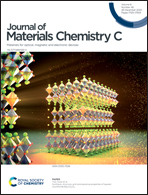Crystallization control and multisite passivation of perovskites with amino acid to boost the efficiency and stability of perovskite solar cells†
Abstract
An (s)-(−)-4-amino-2-hydroxybutyric acid molecule (AHBA) with trifunctional groups is proposed as an effective multisite passivator and crosslinker to improve optoelectronic performance and stability of perovskite films. Here, amino and hydroxyl from AHBA can anchor iodide of PbI64− octahedra, while the carboxyl moiety can coordinate with lead, all of which contribute to high-quality perovskite film with reduced trap state densities. The addition of AHBA also delays the crystallization of perovskites and involves more FA+ and Pb2+ in precursor solution to form full coverage, low defect density and highly crystalline perovskite films with increasing grain sizes. More importantly, the AHBA doping stabilizes the perovskite crystal structure via impeding the loss of surface Br− and ion migration. As a result, both efficiency and stability are significantly enhanced in planar heterojunction perovskite solar cells. The champion device shows an efficiency of 20.31% and retains over 94% of the initial efficiency after 60 days of storage.



 Please wait while we load your content...
Please wait while we load your content...